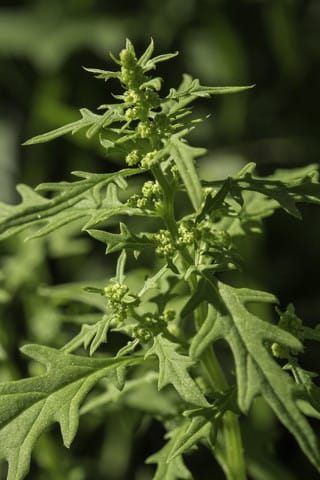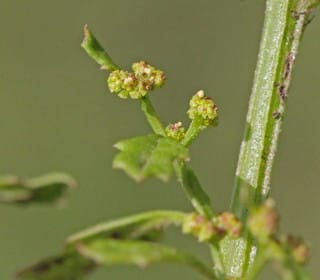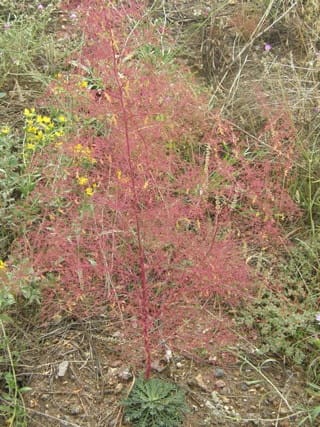This guide initially displays all weeds in the Los Alamos area classified in NM as noxious regardless of shape. Use the selectors below to include nonclassified weeds or select a specific set, either by shape or name.
The term weed is commonly used to denote a plant that is growing in an area where it is not valued. It is officially defined by the USDA Animal and Plant Health Inspection Service as being any plant that poses a threat to agriculture and/or a natural ecosystem. A noxious weed is one that is particularly troublesome and can directly or indirectly injure or cause damage to crops, livestock, or natural resources.
In general, plants that are within their native range live in balance with their environment and are not typically considered to be weeds. Issues can occur, however, if a plant is introduced, either directly or indirectly, to a new ecosystem. These, now non-native plants, may be able to thrive in their new environment. If so, these naturalized plants can fall into one or two categories long term: (1) plants that are valued for their flowers and fruit and (2) plants that are rapidly considered to be weeds. The plants in the latter category are those that are generally regarded as noxious weeds.
While some species shown here are included in the PEEC Flower and Tree Guides, this guide concentrates on some of the nastier introduced species that you might see in your yard or on local trails. In addition, this guide includes some native plants that meet the general definition of weed.
Weed References
A Plan For the Control of Invasive Species on Los Alamos County Open Space — Craig Martin [PDF]
Los Alamos Master Garden Weed List
NMSU Weed Information
SEINet: Southwest Biodiversity
Some Common Lawn and Garden Weeds of Los Alamos, NM — Dorothy Hoard and Teralene Foxx [PDF]
Troublesome Weeds of NM
USDA: Introduced, Invasive, and Noxious Plants
Weed Alert
Weeds of the Los Alamos Area — Teralene Foxx [PDF]
Subject Area Experts (all guides)
Steve Cary (butterflies)
Beth Cortright (insects)
Terry Foxx (invasive plants)
Leslie Hansen (mammals)
Richard Hansen (fish, mammals)
Dorothy Hoard (butterflies, trees)
Chick Keller (flowers, herbarium)
Shari Kelley (geology)
Kirt Kempter (geology)
Garth Tietjen (reptiles)
David Yeamans (birds)
Web Development and Content Management
Pat Bacha
Jennifer Macke
Graham Mark
Akkana Peck
Contact
Please contact us for local nature questions and sightings. We welcome comments, corrections, and additions to our guides.
For more information about local nature, please visit our Nature Blog or subscribe to PEEC This Week.
Make Selection
 Photo: Craig Martin  Photo: Jerry Oldenettel  Photo: Chick Keller |  Fetid GoosefootDYGR (Dysphania graveolens, Chenopodium graveolens)Family: Amaranthaceae (Amaranths) Size: up to 20 in (51 cm) Growth: forb/herb; annual Status: native; nonclassified Native Range: southwestern US, Mexico, and Central America NM Noxious Weed Class: not classified Habitat: disturbed areas near pines and junipers or on rocky hillsides Control Notes: pull up with gloves as the milky sap can cause significant skin and eye irritation Fetid Goosefoot is a native plant that some folks find it offensive due to the strong odor it gives off. It has weed-like properties for its ability to colonize open, disturbed areas in large numbers, but in general is not a large problem in the area. The plant has erect stems with short hairs and lobed leaves which may have dots of resinous material. When blooming, Fetid Goosefoot displays clusters of very small, greenish-yellow flowers with five tepals with appendages shaped like rhino horns. The seeds are smooth and In late summer or early fall, the stems and branches of the plant change color from bright green to red as it dies. Fetid Goosefoot has been used medicinally by several different Native American tribes. The Zuni inhaled the vapor from steeping the plant to treat headaches. The Navajo used it as a lineament and protection during warfare. The leaves and seeds are more or less edible. The leaves can be eaten in small quantities like spinach while the seeds have been ground into a meal for making bread. Lastly, the whole plant has been used as a dye. Info Photos Distribution Flower Guide |
